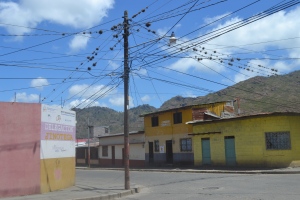Our first stop in Costa Rica was Albergue El Socorro, near Volcano Poas. I chose it from my guidebook as, although I had no idea how I was going to get there with no car, 3 bags and a pre-schooler, it sounded totally authentic and a positive example of rural agrotourism and I wanted us to dive right in to Costa Rican life. I’m so glad we took the gamble. Although the journey was no easy ride (taxi from Alajuela to Carrizal, one hour wait at the side of the road (LC made friends and played dolls up a tree with a local girl), packed bus with sleeping child on knee around hairpin corners for an hour then smiling pickup at Nueva Cinchones by the owner’s son in law to go 8km up the most rickety rock filled stumbling road I’ve ever been on) we got there in the end, and thank god LC slept through the most crazy bits.
Run by Jose and his wife Maria Isabel, they give visitors a truly personal and authentic experience and total nature immersion (as well as being great with kids).

Just before a severe earthquake in 2004, the couple started receiving guests – mainly bird spotters and scientists – as a way to supplement their income as dairy farmers and, more importantly, to reduce their number of cows and to restore pastures for cattle grazing back to pristine forest – the natural habitat for the thousands of birds, insects and wildlife of the area.
“Tourism is much more environmentally friendly than having cows, has much less impact,” Josie told me. This really surprised me, as we are always led to believe that humans do more damage than any other animal. But done right, tourism can provide an income for rural populations instead of having to deforest land for agriculture or animal farming or worse.
For three years post-quake, there were no visitors and the farm and its owners struggled, but with love and determination they rebuilt the farm, alongside 4 beautiful, simple wooden cabins.
The Albergue is not cheap, but includes 3 home-cooked meals a day (with LC staying and eating for free) and a half-day tour with Jose each day, with guests deciding what they would like to do and Jose trying his very best to make it happen. For a solo mama, not having to cook, clean or buy groceries was a bloody joy, as was being taken places with a willing pair of extra hands to allow me to get much-craved exercise.
Our first full day, we got up early and went to see the cows being milked. I was pleased to see the calves drinking milk from their mothers, a practice not allowed in the UK, where they are separated at birth. The cows seemed happy and healthy and well looked after – allowed to roam free all day apart from their twice a day milkings. LC was a bit scared of the cows so we didn’t hang around them long, but other families have been more involved in the process.
After an amazing breakfast, we hiked down through the dense green living forest to a gorgeous river where we swam and jumped across stones. I was glad I had bought a second hand toddler Tula carrier as LC was not up for hiking and it meant I could do a proper walk and not get frustrated. Jose was amazing and carried her in it all the way back.


I also requested that we collect the eggs from the hens, so we did that in the afternoon, less chickens than a week before as 20 got snaffled by a roaming coyote.
The next morning, Jose’s grandchildren arrived, allowing LC some time to make new friends. They fed grass to the chickens, swung from banana vines and pretended to be on a boat – all the good stuff childhood should be about, and which I don’t feel LC gets enough of. 
We then took the kids on an epic adventure again trekking through the narrow, rooty forest paths to a hidden waterfall which I plunged into and felt ALIVE and POWERFUL – things I haven’t felt for a long time.




Only three nights and two days later, having seen yellow tailed montezumas and small bear/squirrel like caite and birds with blinding flashes of blue and of red and heard mysterious and magical calls, I feel so grateful for the precious and magical time we spent at the Albergue. Thank you for making LC pancakes and giving her watermelon outside mealtimes, for making our little family feel so welcome, for allowing us to become part of your family, for showing us the best of Costa Rica.












































